Description
ABSTRAC
TPublic relations are a planned and sustained effort to establish and maintain goodwill and mutual understanding between an organization and its publics. However, many government establishments like the local government councils do not make use of public relations effectively in the administration of public service. Many Nigerians have not felt the impact of local government administration in their area. There is a distant relationship between promise and performance in the local government setting. This research examines public relations practice in local government management in Khana local government. In order to determine the effect of public relations in this local government council, two instruments were used for data collection. The chosen populace were interview and administration questionnaires. Senior members of staff from the local government councils were interviewed. One thousand, two hundred and eighty three 170 copies of the questionnaire were administered both to local government council staff and the public in the area. However, one thousand, two hundred and twenty-two 170 copies were returned. Percentages and average mean point were used to analyze the data collected.
CHAPTER ONE
INTRODUCTION: Local government administration in simple parlance entails the beaucratic governance at the grassroot, by implication it is the management of the government structure with the closest proximity to the people. If this definition is accepted by all, then local government administration becomes an expedient process of making the government structure at the lowest level live up to its constitutional responsibility of improving the living conditions of its people and ensuring massive social transformation of its immediate constituency. How best the simplicity of the above conceptualization, should not be allowed to mislead one by determining the true complex system that makes up the local government administration and the process of making this system effectively functional. A critical review of this system particularly when considered within the context of our subject of discuss, will throw light on some various organs and internal substructures like: Local government Management/administration level, the political structure which is made up the Executive, the technocrats example the Civil Servants, the legislative arms etc. by extension, we also have the residential community, the corporate community, the Civil society etc.Local Government is one of mans oldest political institutions. The earliest form of Local Governments existed in the form of clan and village meetings. In fact, democracy itself originated and developed along the lines of local governance initiatives in the ancient Greek city states.In other parts of the world, local governance was developed along the peoples culture and expectations. Prior to colonization, there were in existence in most Africa enclaves, local administrative machineries founded upon traditional institutions. In the area known as Nigeria today, the existing tribes that make up the geographical areas already had one form of local administration or the other. In the Northern part of the country, the Hausa/Fulani practiced a highly centralized form of government with the Emir at the head as both the political and religious leader. The Emir however delegated his power to district heads the Magajis to oversee the districts that made up the emirates. In the Western part of the country, the Oba firmly held power over towns. This power was delegated to the Baale who administered a town or village and paid royalties to the Oba at specified times of the year, Adeyemor 2005. The Igbo of the Eastern part however were republicans and egalitarians in nature. That notwithstanding, there were still in existence, the Ohaneze an assembly of men who sat in the village square to take decisions on behalf of the people. Some parts of the East still have village heads and Igwes who administered a particular town with the advice of the council of elders. Over all, central control was exercised by a body of local chiefs. As the industrial revolution proceeded and towns developed, there came new needs for highways, street paving and lighting, more efficient police, better public health, and, eventually, public education. The colonial administration recognised local administration by enacting the Native Authority Ordinance of 1914, Native Court Ordinance of 1914 and Native Court Revenue Ordinance of 1916 Dike 2011, in www.wikipedia.org. Nonetheless, the period 1976 1979, in which the military administration of Murtala/Obasanjo lasted, is usually regarded as a period of watershed in the annals of Local Government Administration in Nigeria Awotokun, 2005, p.129. It was the first time a concerted effort would be made by the federal government to brighten the future of Local Government. Local Government was not only accorded its place of pride in the socioeconomic wellbeing of the country, it was also seen as a way of bringing government closer to the people. Consequently, a uniform system known as single tier structure was adopted throughout the country. This uniformity can be conceptualized in terms of: a The functions of Local Governments; b The structure of the Local Governments; c The financial resources of the Local Governments; d The place of traditional institutions in the Local Governments; e relationships with State Government; and f Law enforcement. In terms of functions, there was uniformity of function and responsibilities for all the Local Governments throughout the federation. These functions and responsibilities were later to be enshrined in the 1979 Constitution of Nigeria. The political and administrative structures were also uniform in all the Local Governments in Nigeria. Every Local Government council was headed by an elected chairman. The administrative wing was headed by career administrator styled secretary to the Local Governments. In addition all Local Governments were departmentalized Awotokun, 2005, p.129 The 1999 constitution has recognized Local Government existence. The system of Local Government by democratically elected government councils is under this constitution guaranteed, and accordingly, the government of every state shall, subject to Section 8 of this constitution, ensure their existence under a law which provides for the establishment, structure, composition, finance and functions of such councils. Under this composition we have the executive, the legislature and the judiciary. The executive function is vested in the chairman, vicechairman, supervisor or supervisory councilors, and the whole machinery of Local Government bureaucracy. The legislative functions are vested on the councilors, who represent the wards which make up the Local Government Area Federal Republic of Nigeria Constitution 1999. In Nigeria today, there are over 250 ethnic groups with diverse cultures and tongues. These ethnic groups are further divided into communities. These communities form the constituents of most Local Governments in Nigeria. By carving out Local Governments amongst people of the same community, government is preserving such long traditional association and using same to foster the interest of the people concerned. It is on this platform that Adeyemo 2005,p.77 sees Local Government as a system of local administration under local communities that are organized to maintain law and provide some limited range of social amenities. This implies that a Local Government is a political and administrative organ that is empowered by law to administer a specified locality. Participation by the citizens in governance is one of the underlying precepts of democracy and modern day notion of government. Local Governments served as avenues through which the people participate in governance. This is done through participation in the electoral processes and decision making in the local communities. There are 774 Local Government Areas LGAs in Nigeria. Each Local Government Area is administered by a Local Government Council consisting of a chairman who is the Chief Executive of the LGA, and other elected members who are referred to as Councilors. According to Adeyemo 2005,p.79, the basic functions of the Local Government are: a to make appropriate services and development activities responsive to local wishes and initiatives by devolving or delegating them to local representatives body; b to facilitate the exercise of democratic self government close to the Local Government levels of our society, and to encourage initiatives and leadership potential; c To mobilize human and material resources through the involvement of members of the public in their local development; d To provide a two way channel of communication between local communities and government both state and federal. Invariably, this grassroots democracy, as Adeyemo 2005, p.80 calls it, is primarily aimed at giving the vast majority of the people the fullest opportunity to participate in determining their own destiny. But it is obvious that the fourth function listed above is very important because it is the basis by which the government and the people interrelate. These many functions may be cumbersome for the State and Federal Government to perform because of the distance separating them and the people. These functions can be best and effectively performed by the Local Government. Also, due to the vast nature of the country, the presence of government whether at the Federal or State levels have not been felt much at the Local Government. The resultant effects being neglect and distrust for government. In a bid to bring the activities of government closer to the people, Local Governments were created to serve as conduits through which governments policies are communicated to the people. In other words, the creation of Local Government is intended to bring people of common heritage or ancestry together as a political unit to further their interest and increase their participation in government business. One of the channels through which people relate with government and participate in the act of governance is by communication. Communication sustains relationship between people, friends, family, nations, organisation and the target publics and between government and the people. Public relationsPRs is a persuasive communication that can be used to develop and sustain relationship between government and the people. Hence, PRs is accepted as a management function in the formulation of policy and decision making. It is the way in which an organisation makes and keeps contact with those who affect its life and growth. Therefore, skilful management is being given to the effective use and application of PRs for the growth of any organisation Soeze, 2006, p.37. The wellknown definition of public relations as stated by the British Institute of Public Relations BIPR has it that PRs is: the deliberate planned and sustained effort to establish and maintain mutual understanding between an organisation and its public as well as the planned effort to establish and improve the degree of mutual understanding between an organisation or individual and any group of persons or organisations with the primary object of assisting that organisation or individual to deserve, acquire and retain a good reputation BIPR, in Oboh and Enobakhare, 2010, 307. The above definition implies that the fundamental purpose of public relations practice is to establish a twoway flow of mutual understanding based on truth, knowledge and full information Nkwocha,1999, p.20. Invariably, PRs entails mutual understanding between an organisation or government and the public. It should be noted that public relations is located within the ambit of governance, industry, community, social affairs, international affairs as well as educational institutions with a calculated vision of bettering mutual understanding. Nigeria operates a federal system of government with the Local Government as the third tier. As the political link between the local people otherwise called the grassroots, and the State Government, Local Government authority enjoy the freedom of action, which makes it possible to discharge the function conferred upon it by the constitution. The enviable position Local Government authority occupies in the political structure of the country imbues people with the expectation that this level of government should bring development to the peoples doorstep Anele, 2008, p.398. The citizens of this country realise the utility of Local Government authority in actualKhanag both collective and genuine goals, and individual interest. However, many have complained of the Local Government functions, and wondered whether they are really close to those in the grassroots. Many argue that the Local Government had not met the aspirations of the public. Perhaps, there is problem of effective use of communication through public relations techniques between the Local Government authorities and those at the grassroots. This study therefore aims to determine effect of public relation on local government management in Khana Local government.

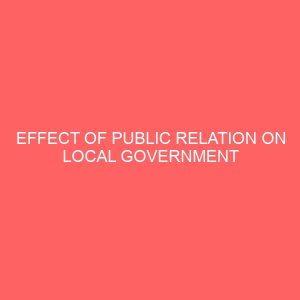

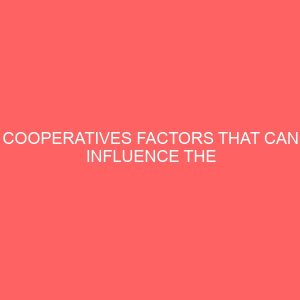
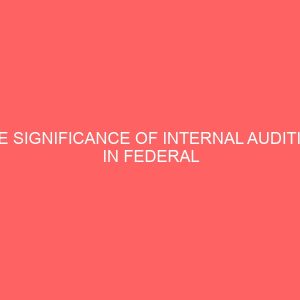
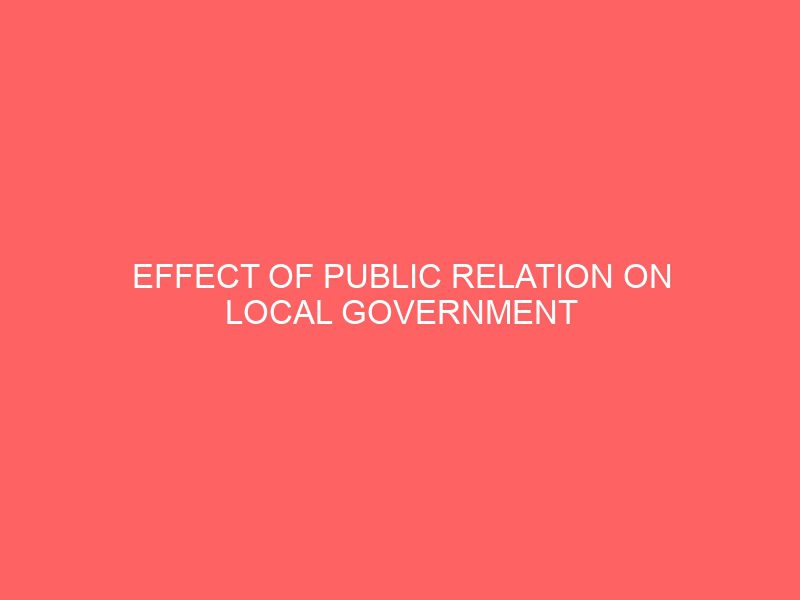
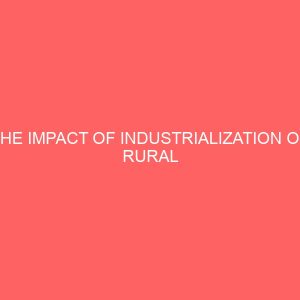
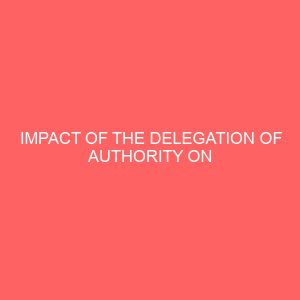
Reviews
There are no reviews yet.